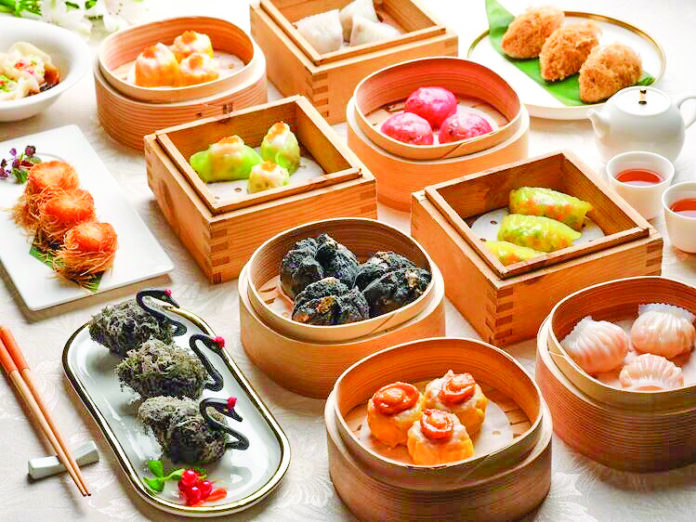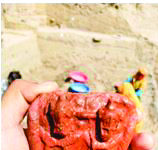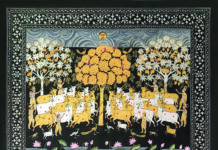Author and screenwriter Advaita Kala will write an occasional column for The Sunday Guardian.
There are restaurants you go to for the food. And then there are restaurants you go to for the feeling or as Gen Z would call it “the feels”. Fujiya, perched on the leafy embassy-strewn stretch of Malcha Marg in Delhi, casually falls into the second category. Of course, it serves food — and plenty of it, mostly Indo-Chinese with a loyal clientele who swear by the butter garlic prawns and chilli chicken — but that’s not why you go there. You go for the time travel.
Step into Fujiya and it’s as if someone pressed pause on 1994. Not in a curated, intentional way that today’s hipster cafés strive for — no Edison bulbs, no artisanal soy sauces, no wall of fake foliage and servers with vibes — but in the gloriously unselfconscious way of a place that simply is. The interiors are drenched in dramatic shades of red. Burgundy upholstered booths, crimson walls, thick red curtains that look like they might once have done duty in a Doordarshan studio — all conspiring to wrap you in a velvet-draped flashback, with a little of glitter.
And then on one wall there’s Mount Fuji — incongruous and oddly endearing — a nod to the restaurant’s name (Fujiya!) and a parade of dishes that wouldn’t pass muster in either Beijing or Tokyo but are beloved in Delhi before we “refined” our tastebuds with “authenticity”. But ask any Dilliwala, falling back into the culinary embrace of Indian styled Chinese is not a lapse its an homage!
The menu reads like a 90s wedding reception greatest hits album. There’s Golden Fried Prawns, Chicken Drumsticks, Chilli Garlic Noodles, and the unmistakably Desi-Chinese Chilli Chicken that arrives on a bed of onions with a slick of red gravy so shiny, it could star in its own shampoo commercial. Spring rolls are fat, floury, and unapologetically stuffed. The Sweet Corn Soup comes in no fuss ceramic bowls —— and tasting like childhood.
And here’s the thing: it’s delicious, always was and always will be. But not in a Michelin-starred way instead in the way your favourite college canteen was delicious. Or how your local club served Chicken Lollipop with flair and tomato ketchup with red chillis that doubled as ‘hot sauce’. It’s comfort food of the highest order — seasoned with memory, marinated in emotion, and stir-fried with stubborn consistency, diet fads, cuisine trends be damned! And there is a refreshing honesty in that.
Regulars at Fujiya span generations. Diplomatic families who live nearby and have been tipped off by departing compatriots for decades. Journalists from the nearby Press Enclave, barring traffic snarls. Nostalgic old Delhiites who drive across town because they “don’t make chowmein like this anymore”, people like me who grew up in its vicinity, and a trip to Fujya was a pilgrimage of culinary delight. There are rumours — persistent and entirely unverifiable — that a former Prime Minister once had a soft spot for their Hot & Sour Soup. The waitstaff, meanwhile, have barely changed since the Vajpayee era. They glide efficiently across the red carpet, immune to trends, Instagrammers, and the concept of QR-code menus, but Paytm works, even Fujiya has not stayed immune to digital payments, not for the tech benefits but moreso for its practicality.
If Fujiya looks like a late 70s- 80s Bollywood villian’s den, then blame it on the alcohol bottles encased in locked glass cabinets, a decisively socialist India touch, where Alcohol was displayed and protected under lock and key, unlike the unencumbered accessibility and tactility of today! It’s a particularly charming touch, yet again replete with nostalgic fervour. This display feels like an affectionate oversight, like your uncle with the same hairstyle he wore in the 1970s and doesn’t notice that the calendar has flipped.
Fujiya isn’t just stuck in time — it relishes it. It’s from an era when dining out was a treat, when the family car was brought out for a Saturday dinner or a treat post a favourabe exam result, and when Chinese food was a little exotic, a little glamorous, and entirely ours. This was before chilli garlic became a potato chip flavour, before dim sum were available at airports, and before every mall had a “pan-Asian” lounge playing Kygo remixes. Fujiya remains blessedly untouched by fusion or reinvention and isn’t bothered by the preciousness of the “dining scene”.
There’s a kind of defiant integrity in that. Fujiya knows what it is — and more importantly, what it is not. It is not modern. It is not sleek. It is not trying to rebrand. It has no hectic marketing or “deals” and certainly no food stylist. Its loyalty program is the loyal customer, even one like me, who finds their way back after exotic culinary indiscretions.
And in a city where restaurants come and go with frightening speed, Fujiya’s very survival is its triumph. In a world obsessed with reinvention, there’s something revolutionary about staying the same. Every bite is a throwback. Every visit, a warm hug from a simpler time.
So go. Take your friends, your parents, your children. Order the crispy lamb, the kung pao chicken, the American chopsuey (yes, the sweet one with the fried noodles on top). Bask in the crimson glow. Raise a toast to Mount Fuji.
And don’t forget to glance at the locked liquor cabinet— it’ll still be there, long after the fancy cafes have closed shop.
Because Fujiya isn’t just a restaurant. It’s a love story. And like all great romances, it endures.








